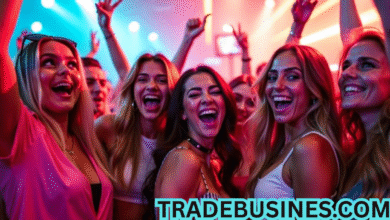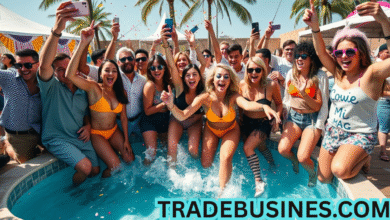The Evolution of Influencer Culture
InfluencersGoneWild has drastically evolved over the past decade, fueled by the surge in social media platforms and a changing perception of celebrity. In a world where fame can be achieved with a smartphone and internet connection, influencers have carved out a niche that blends marketing, entertainment, and personal branding. Platforms like Instagram, TikTok, Snapchat, and Twitter have birthed a new generation of public figures who use authenticity and relatability as their brand currency.
This evolution has created a space where everyday individuals can amass followers and shape public opinion. But with this rise comes a blurred line between personal life and public persona. It is in this context that the term “InfluencersGoneWild” emerges, a phrase that symbolizes the extremes and unfiltered side of internet fame.
The Concept Behind InfluencersGoneWild
“InfluencersGoneWild” is more than a viral hashtag or trending phrase. It encapsulates a phenomenon where influencers, either intentionally or unintentionally, break societal norms or platform rules. Whether it’s through controversial posts, public meltdowns, or sharing explicit content, this concept reflects the darker or more uninhibited side of influencer culture.
Unlike traditional celebrities, influencers are often seen as more approachable and relatable. This perception creates an illusion of intimacy between them and their audience. However, it also places them under constant scrutiny, where every misstep is amplified. InfluencersGoneWild captures these moments of raw, sometimes reckless, exposure that defy expectations and challenge the norms of polished online personas.
The Allure of Authenticity and Uncensored Content
In the digital age, audiences crave realness. Heavily filtered posts and curated lifestyles have lost some of their charm as followers seek genuine experiences and unedited glimpses into the lives of their favorite influencers. InfluencersGoneWild taps into this craving for authenticity. It shows the human, messy, and unpredictable side of internet fame.
Some influencers deliberately lean into this rawness, using it as a way to differentiate themselves from their more polished counterparts. They post content that might be considered inappropriate, shocking, or controversial to stand out in an oversaturated market. This can include anything from rants about personal experiences to revealing behind-the-scenes drama. While risky, this strategy often garners viral attention, boosting engagement and growing their audience.
The Thin Line Between Fame and Infamy
While some influencers thrive on unfiltered content, others fall from grace due to misjudged behavior. The term InfluencersGoneWild also covers scandals that lead to reputational damage, brand fallout, and even legal consequences. From offensive remarks to public intoxication and dangerous stunts, the internet never forgets, and the court of public opinion is quick to deliver its verdict.
In many cases, influencers forget the responsibilities that come with their platform. What might be intended as edgy or humorous can backfire spectacularly. The consequences can be swift: sponsorships pulled, followers lost, and careers damaged. Yet, paradoxically, these incidents often attract more attention, sometimes even leading to a resurgence in popularity. The allure of watching influencers implode is a testament to society’s fascination with celebrity downfall.
Monetizing the Wild Side
Some influencers have turned the InfluencersGoneWild trend into a business model. Platforms like OnlyFans and Patreon offer ways to monetize more explicit or controversial content directly. These platforms bypass traditional advertising and rely on direct fan support. For some creators, this freedom allows them to share uncensored material without fear of demonetization or censorship.
This monetization of personal exposure creates an interesting dynamic. Followers who pay for this content often expect more intimacy and transparency, pushing influencers to further blur the line between public and private. The demand for this type of content reflects a larger cultural shift toward voyeurism and the consumption of “real” content, no matter how provocative.
Societal Reflections and Cultural Shifts
InfluencersGoneWild also reflects broader cultural trends. In a society obsessed with surveillance, performance, and virality, the concept speaks to the tension between personal freedom and public accountability. Social media rewards boldness, and sometimes that boldness crosses the line into controversy or chaos.
This trend also raises questions about mental health, privacy, and the pressures of online fame. Constantly being in the spotlight can lead to burnout, anxiety, and impulsive decisions. Many influencers experience the psychological toll of needing to stay relevant in a fast-paced digital environment. The wild moments captured online often stem from real struggles beneath the surface.
Moreover, audiences play a role in this cycle. Followers often encourage extreme behavior through likes, shares, and comments. Outrage and shock are engagement drivers, and many influencers learn that going wild can pay off. This creates a feedback loop where content becomes increasingly boundary-pushing to maintain relevance.
Backlash, Redemption, and Rebranding
The internet is quick to cancel, but it also offers the possibility of redemption. Many influencers who have gone wild find ways to bounce back. Whether through apology videos, public apologies, or complete rebrands, some manage to rebuild their image. The public has a short memory, and in a landscape driven by constant content, yesterday’s scandal is often tomorrow’s forgotten drama.
Rebranding strategies vary. Some influencers adopt a more mature or professional tone, while others lean into their past controversies and build a persona around resilience and growth. This ability to transform and reinvent is a key feature of influencer culture, where adaptability is crucial for long-term success.
However, not all recover. Some influencers lose their platforms entirely or retreat from the spotlight altogether. The ones who endure are those who can turn the narrative in their favor, learning from mistakes and reshaping their public image.
Legal and Ethical Considerations
As the lines between content creation and personal exposure blur, legal and ethical issues come into play. InfluencersGoneWild moments can involve defamation, copyright violations, or violations of platform guidelines. Platforms like Instagram, TikTok, and YouTube have community standards, and violating them can lead to suspension or bans.
There are also questions about consent, especially when influencers share content involving others without permission. Furthermore, influencers who target younger audiences must be especially careful, as explicit or controversial content can be seen as inappropriate or predatory.
Regulatory bodies in some countries have begun to pay attention, enforcing transparency in advertising and punishing misleading content. As influencer culture becomes more professionalized, there’s an increasing push for accountability and ethical standards.
Influence Beyond the Internet
The impact of influencers who go wild extends beyond the digital realm. They shape societal conversations, influence consumer behavior, and even affect political discourse. Some influencers use their platform for activism or advocacy, while others inadvertently highlight issues like cyberbullying, addiction, and mental health through their own struggles.
The visibility of influencers means their behavior has ripple effects. When they go off-script, it can spark discussions about parenting, media literacy, and online safety. Schools, parents, and policymakers are increasingly concerned with how influencer culture shapes the values and aspirations of younger generations.
This cultural impact cannot be ignored. Whether through drama, disruption, or inspiration, influencers hold real power. And when they go wild, that power is both magnified and scrutinized.
The Future of InfluencersGoneWild
As digital culture continues to evolve, the phenomenon of InfluencersGoneWild is unlikely to disappear. In fact, it may become more prevalent as competition increases and attention becomes harder to capture. The next phase of influencer culture will likely see more boundaries tested, more scandals unfolding, and more debates about what is acceptable in the public digital space.
At the same time, audiences are becoming more savvy. They can differentiate between genuine vulnerability and manufactured controversy. As a result, influencers will need to balance authenticity with responsibility. The days of unchecked behavior may be numbered as platforms, brands, and viewers demand higher standards.
New platforms may also emerge, catering specifically to uncensored or adult content, further professionalizing what was once considered fringe. This could lead to a tiered ecosystem of influencer engagement—one for mainstream, sanitized content and another for edgier, less restricted material.
Conclusion
InfluencersGoneWild captures a complex and evolving reality in digital culture. It symbolizes the clash between authenticity and sensationalism, fame and responsibility, freedom and consequence. While the term often evokes scandal and shock, it also reflects deeper truths about our relationship with digital personas, public scrutiny, and the hunger for raw, unfiltered content.
As long as influencer culture continues to thrive, these wild moments will remain part of the landscape—sometimes cautionary, sometimes entertaining, and always reflective of the digital age we live in.
Frequently Asked Questions
What does “InfluencersGoneWild” mean?
It refers to moments when influencers act outside the norms of expected behavior, often posting controversial or explicit content that garners public attention.
Why do influencers engage in such behavior?
Many do so to stand out in a crowded digital space, attract attention, or express authenticity. Others may act impulsively due to stress, burnout, or the pressures of constant engagement.
Is this trend harmful or just entertainment?
It can be both. While some viewers see it as entertaining, the trend can also highlight issues like mental health struggles, platform exploitation, and the ethical responsibilities of influencers.
Can influencers recover from going viral for the wrong reasons?
Yes, many manage to rebuild their reputation through InfluencersGoneWild rebranding, apologies, or by pivoting to different types of content. However, some are permanently impacted.
What does the future hold for influencer culture?
As audiences demand more accountability and transparency, influencer culture may become more regulated. However, the hunger for real and raw content suggests that boundary-pushing behavior will remain part of the landscape.



